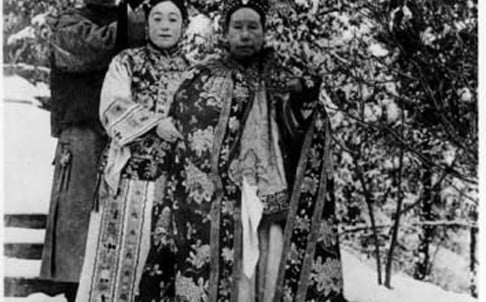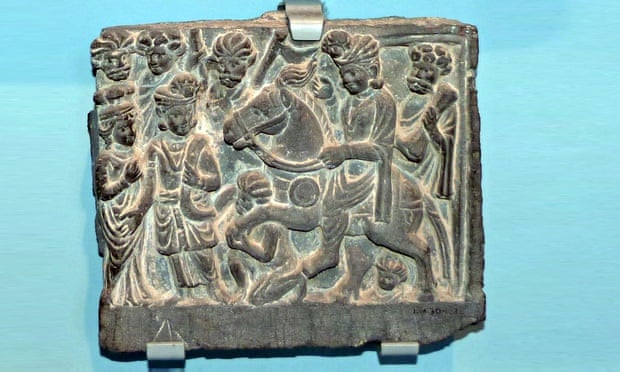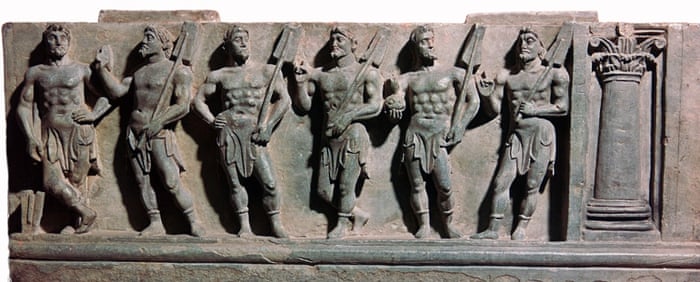
During a behind-the-scenes tour for the media, Freer Gallery of Art and Arthur M. Sackler Gallery officials show how photographers create three-dimensional images of objects. (Kate Patterson/For The Washington Post)
They chose a pretty piece for last.
Photographer John Tsantes had placed the “Seated Princess” — an opaque watercolor and gold painting that is part of the famed Islamic collection of the Freer Gallery of Art and the Arthur M. Sackler Gallery — on his table and focused the cutting-edge digital camera mounted overhead. And in the split-second it took for the camera’s shutter to close, the museum completed a multi-year effort to digitize its 40,000-item collection.
The 400-year-old artwork was the last of works owned by the Smithsonian’s Asian art museums to be digitally recorded. The images go online Jan. 1, making this boutique Smithsonian the first of the franchise to share its entire collection with a global audience.
The milestone is especially gratifying to director Julian Raby, an early adopter of digital photography and an advocate of the Internet’s power to transform museums.
“It’s part of the democratization of art,” Raby said. “John began what was the Smithsonian’s first digital photography studio, so it’s very nice that we are also the museum that is the first to digitize its whole collection.”

Julian Raby, director of the Freer and Sackler galleries, stands next to an image of the last item in the collections that the museums will digitize. The entire collections will go online beginning Jan. 1. (Kate Patterson/For The Washington Post)
Raby said the technology pushes the boundaries of what it means to be a museum because it allows for unrestricted study and enjoyment of the collection. Next month’s release will include at least one image of each work — the majority in high-resolution — and the collection will be searchable and largely downloadable for non-commercial use.
Some of the galleries’ most popular items will be available for download as computer and smartphone backgrounds.
Raby doesn’t worry that putting the collection online will mean a reduction in visitors. In fact, he predicts the exact opposite.
“We strive to promote the love and study of Asian art, and the best way we can do that is to free our unmatched resources,” he said. “I think it will intensify interest, and that will lead to more visitors.”
Courtney O’Callaghan, director of digital media and technology, said the last item was carefully chosen. A composite design featuring a woman in a robe surrounded by interlocking figures, it illustrates the value of the project: although aesthetically and historically important, the work attributed to Muhammad-Sharif Musawwir is virtually unknown.
“About 78 percent of the collections have never been displayed. Now the public can see them, and in some cases, see them better,” O’Callaghan said.
To illustrate the idea, Tsantes tapped the computer keyboard and a section of the approximately 7-by-12-inch work exploded on the screen, the colors intense, the figures clear.

Cory Grace, the rights and reproductions coordinator and a digital assistant at the Freer and Sackler galleries, pulls a transparency from the files in the museum’s photo lab. (Kate Patterson/For The Washington Post)
The technology allows the museum to standardize colors, O’Callaghan said. Each image is photographed next to a color bar with different hues numbered and therefore measurable. This removes the guesswork from the printmaking.
“It’s instant, it’s precise. And we have total control,” she said.
It took many years and 6,000 staff hours to complete the collection. The museum’s three photographers usually completed between 100 and 200 objects a week. Museum officials didn’t calculate the cost of the effort; they said it was integrated into the regular work of the museum for many years, and impossible to estimate.
Some of the most difficult items — including large textiles and furniture and extremely heavy sculptures — were only digitized recently, Tsantes said. Termed “the problem children,” these items required multiple people to set up the shot, or that the camera had to be mounted high over the works (creating safety issues should it fall).
“We always said we’ll do that later, but now is later,” he laughed.
Although at least one image from every item in the collection will be posted online, the work of the photography studio isn’t over. The museum continually acquires new work, and those items will be added to the online collection.
“This isn’t the end of the work, this is the end of the backlog,” O’Callaghan said.
In addition, the staff is working with new technology. They are trying to create 360-degree images of every three-dimensional artwork. As an example, the staff displayed a Korean ceramic pitcher. Still images were stitched together to create a short video panorama of the piece. In this way, the online viewer can get a better view of the work than a visitor to the museum can, O’Callaghan said.
Raby envisions new research and even new artwork will result from the effort, fulfilling the museum’s basic mission of preserving and sharing its masterpieces
“Over the next few years, we’ll figure out how we dive deeper,” he said.
GARDEN AND COSMOS: THE ROYAL PAINTINGS OF JODHPUR
Listen to clips from the exhibition audio guide and take a detailed look at select paintings in this interactive feature.Online Exhibitions Freer Sackler
The Smithsonian's Museum of Asia Art
ANCIENT NEAR EASTERN ART
- Caravan Kingdoms: Yemen and the Ancient Incense Trade
- Gallery Guide: Royal Riches
- Wine, Worship & Sacrifice: The Golden Graves of Ancient Vani
ARTS OF THE ISLAMIC WORLD
- Style and Status: Imperial Costumes from Ottoman Turkey
- Iraq and China: Ceramics, Trade, and Innovation
- Caliphs & Kings: Art and Influence of Islamic Spain
- Gallery Guide: Arts of the Islamic World
- Gallery Guide: Visual Poetry
- The Adventures of Hamza
- Haft Awrang (Seven Thrones): A Royal Persian Manuscript by Jami
CHINESE ART
- Perspectives: Mei-ling Hom
- China History Timeline
- Iraq and China: Ceramics, Trade, and Innovation
- Cai Guo-Qiang: "Traveler"
- Return of the Buddha: The Qingzhou Discoveries
- Gallery Guide: Chinese Arts of the Brush
- Word Play: Contemporary Art by Xu Bing
- Ancestor Worship Today
- A Closer Look at Conservation: Chinese Commemorative Portraits
JAPANESE ART
- Hiroshi Sugimoto: History of History
- Hokusai
- Dream Worlds: Modern Japanese Prints and Paintings from the Robert O. Muller Collection
- Faith and Form: Selected Calligraphy and Painting from Japanese Religious Traditions
- Isamu Noguchi and Modern Japanese Ceramics
- Masterful Illusions: Japanese Prints from the Anne van Biema Collection
SOUTH ASIAN AND HIMALAYAN ART
- Garden and Cosmos: The Royal Paintings of Jodhpur
- Himalayas: An Aesthetic Adventure
- The Sensuous and the Sacred: Chola Bronzes from South India
- Tibetan Healing Mandala
- Gallery Guide: Understanding South Asian Art
- Devi: The Great Goddess
- Puja: Expressions of Hindu Devotion
ART ACROSS ASIA
- East of Eden: Gardens in Asian Art
- Encompassing the Globe: Portugal and the World in the 16th and 17th Centuries
- Facing East: Portraits from Asia
- Caravan Kingdoms: Yemen and the Ancient Incense Trade
- Asian Games: The Art of Contest
- Iraq and China: Ceramics, Trade, and Innovation
- Celebrate the Arts of the Silk Road
- Gallery Guide: The Arts of Buddhism
- Gallery Guide: Luxury Arts of the Silk Route Empires







